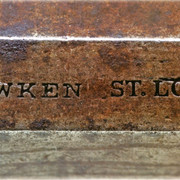Were original Hawken barrels made from solid bar stock or were they made from strips of steel/iron hammer forged around a round bar, damascus like ?
Fred
Fred


Old Ford said:Were original Hawken barrels made from solid bar stock or were they made from strips of steel/iron hammer forged around a round bar, damascus like ?
Fred
Original Hawken barrels would have been forge welded using iron skelps. The manufacturing technology to produce steel alloys and deep hole drilling was not developed until after the Hawken brothers time.Old Ford said:Were original Hawken barrels made from solid bar stock or were they made from strips of steel/iron hammer forged around a round bar, damascus like?
Fred
Do you really think they were bored from solid stock?
eggwelder said:I`ve seen in a blacksmithing book that shows two bars of iron with a fuller down the center of each forge welded together. leaves you only two seams. forged to octagon then it is drilled and bored out to the desired calibre.
there is also a method of wrapping a flat iron bar around a mandrel lengthwise and forge welding leaving only one straight seam. forged to shape then bored out.
book is called "The Art of Blacksmithing" by Alex Bealer
Old Ford said:Mtn Meek,
I have never had an original Hawken in my greasy hands ( though I wish )
On close inspection was it common to see the traces of the ribbons of the hammer forged barrels.
I have only seen a few barrels like this.
Some of the ones actually had three or four barber pole like seams the full length of the barrel.
They were not cracks or open fissures but a fine like seam wrapping the length of the barrels.
They were only feint like lines showing through the draw filed flats, even though the barrels were 150+ years old.
The lines were more evident on the bottom flats covered by the stock.
Thank you for the information.
Best regards!
Fred

Enter your email address to join: